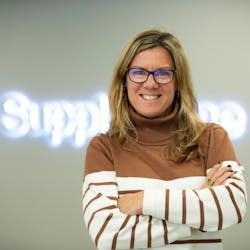Skill sets outweigh gender in filling STEM-field positions
Sarah Rich is vice president, operations & customer success, at Supplyframe.
According to U.S. census data, the percentage of women in engineering occupations has increased from a mere 3% to 15% over the past 50 years. While the needle is pointed in the right direction, there’s still a lot of room to grow that number. What seem to be the biggest hurdles to women interested in engineering and automation fields? And what difficulties are employers encountering as they work to increase that number?
With the skilled labor shortage that began pre-pandemic and was heightened by the shutdown, how can organizations capitalize on the availability of women to fill these roles?
Sarah Rich, vice president, operations & customer success, Supplyframe: Creativity and open-mindedness are the name of the game when it comes to broadening opportunities and finding great people. Organizations should take a look at potential skill sets that can be directly transferable to a given set of job requirements. For example, a software company may find they are in need of team members to train on their solutions. Perhaps a schoolteacher, an occupation that is traditionally more female-dominant, who has strong presentation and technology skills with an ability to command a room while facilitating learning would be a good candidate.
In her relatively famous study, published in the Harvard Business Review, MIT’s Susan Silbey and her colleagues found that women in engineering experienced a significant amount of gender bias not only at the college level, but even more so in internships and co-ops and then when entering the workforce. She estimates that 40% of women who earn an engineering degree either quit or never enter the profession. What can be done to nurture and develop these women, especially early in their careers?
Sarah Rich, vice president, operations & customer success, Supplyframe: Embracing the expansion of organizations like Women in Electronics who strongly focus on offering support and growth of women in the field is a key way long-term career paths for women can be created. It’s important to have communities within a given industry that women can resonate with and rely on for helping with professional and personal development.
One of the other findings in Silbey’s report is that the women who participated were hoping to make a more socially conscious impact in their engineering pursuits than the males in the study. What, if anything, does this tell us about gender bias? And, if the report is indicative of a real female desire to make a difference, where might women find those types of jobs to have a positive impact on society and civilization with their engineering and automation expertise?
Sarah Rich, vice president, operations & customer success, Supplyframe: On the surface, one could argue that women tend to be more empathetic and altruistic, which could point to a preference for socially conscious companies, but, truthfully, more women and men alike are highly concerned about the type of company they work for and the values those companies hold. The concept of “social transformation” should be of the highest priority for each and every company as cultural evolution is critical for organizations to remain attractive, competitive and relevant. It’s usually not too difficult to assess how important these factors are for a company, as typically marketing efforts will showcase their environmental, social and governance (ESG) standards and processes. Additionally, both-third party rating scales and resource sites dedicated to ranking socially responsible companies are becoming more prevalent.
According to the latest research from the Society for Women Engineers, females earn 10% less than their male counterparts. How does this impact a woman’s interest in entering an automation-related field, and what can be done to counteract this?
Sarah Rich, vice president, operations & customer success, Supplyframe: Women may find themselves on the short end of the equality stick for compensation, but there are quite a few things that can be done. First, women should spend time researching, educating themselves and knowing their worth. Not only are several resources available out on the web to help with these efforts, but this is a perfect example of how a women-focused support network can be invaluable in providing guidance and support.
Women can also work toward gaining confidence in advocating for themselves and asking for what they want. Women can even build on their courage a bit to spread their wings. Studies show when evaluating new opportunities, women tend to only go for it if they cover all skills and abilities needed, whereas men tend to apply as long as they have at least half to most. The more comfortable women become in speaking up and the more educated industries as a whole become in the importance of gender equality, the sooner we’ll all enjoy a fairer landscape.
How can mentoring programs help women to stay the course and feel fulfilled in their automation or engineering pursuits?
Sarah Rich, vice president, operations & customer success, Supplyframe: We believe that mentorship programs and women-led initiatives in the workplace help foster a greater sense of community and keep both women leaders and young professionals engaged in their careers. Leaders really have to think about what’s important to people. It’s not just about money or titles; it’s very much about the culture. Companies can truly transform by embodying these values, by helping people understand the role they play within the organization and within the industry at large.
What sorts of initiatives is your company involved with to encourage female participation in the automation field?
Sarah Rich, vice president, operations & customer success, Supplyframe: Supplyframe and our parent company Siemens have a strong focus on expanding leadership opportunities across genders and professional development for all employees. An example of this is our sponsorship of Women in Electronics, a community of progressive women leaders at all stages of their careers dedicated to expanding the opportunities for women in the fast-paced electronics industry. Beyond simply sponsoring this wonderful organization and its mission, we also provide memberships to our employees regardless of gender or orientation, so our staff has access to all of the development resources and mentorship opportunities Women in Electronics provides.
About the Author
Mike Bacidore
Editor in Chief
Mike Bacidore is chief editor of Control Design and has been an integral part of the Endeavor Business Media editorial team since 2007. Previously, he was editorial director at Hughes Communications and a portfolio manager of the human resources and labor law areas at Wolters Kluwer. Bacidore holds a BA from the University of Illinois and an MBA from Lake Forest Graduate School of Management. He is an award-winning columnist, earning multiple regional and national awards from the American Society of Business Publication Editors. He may be reached at [email protected]

Leaders relevant to this article:


